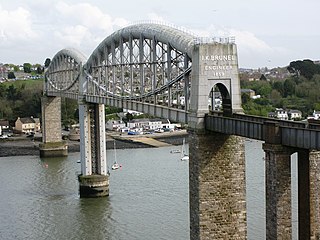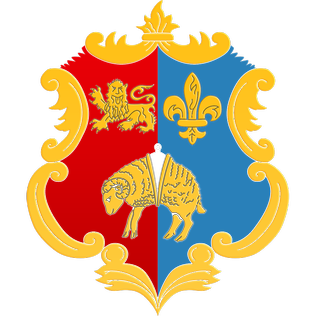Related Research Articles

The Royal Albert Bridge is a railway bridge which spans the River Tamar in England between Plymouth, Devon and Saltash, Cornwall. Its unique design consists of two 455-foot (138.7 m) lenticular iron trusses 100 feet (30.5 m) above the water, with conventional plate-girder approach spans. This gives it a total length of 2,187.5 feet (666.8 m). It carries the Cornish Main Line railway in and out of Cornwall. It is adjacent to the Tamar Bridge which opened in 1962 to carry the A38 road.

The British Sub-Aqua Club or BSAC has been recognised since 1954 by UK Sport as the national governing body of recreational diving in the United Kingdom.

Lynmouth is a village in Devon, England, on the northern edge of Exmoor. The village straddles the confluence of the West Lyn and East Lyn rivers, in a gorge 700 feet (210 m) below Lynton, which was the only place to expand to once Lynmouth became as built-up as possible. The villages are connected by the Lynton and Lynmouth Cliff Railway, which works two cable-connected cars by gravity, using water tanks.

Resurgam is the name given to an early Victorian submarine and its prototype, designed and built in Britain by Reverend George Garrett. It was intended as a weapon to penetrate the chain netting placed around ship hulls to defend against attack by torpedo vessels.

DSRV-2Avalon was a Mystic-class deep-submergence rescue vehicle rated to dive up to 5000 feet to rescue submarine crews trapped deep under the sea. The submarine was acquired in response to the loss of the USS Thresher, so that the Navy would have a way to rescue trapped submarine crews.

The Blue Line is a metro rail line of the Delhi Metro, a rapid transit system in Delhi, India. It is the longest line of the network and consists of a Main Line(Line 3) with 50 stations from Noida Electronic City to Dwarka Sector 21, with a length of 56.11 kilometres and a Branch Line(Line 4) consisting of 8 stations from Vaishali to Yamuna Bank, with a length of 8.51 kilometres.

Tavistock Association Football Club is a football club based in Tavistock, Devon, England. They play in the Southern League Division One South.

Stadium House in Park Street, Cardiff, Wales, is the third tallest building in Cardiff, Wales, which stands next to the Millennium Stadium. The 255 feet (78 m) tall building is owned by BT Group, and underwent a £7.1 million refurbishment programme in 2002.

The Blue Lagoon Local Nature Reserve is a Local Nature Reserve in Bletchley, Milton Keynes in Buckinghamshire, United Kingdom. The Blue Lagoon is the only Local Nature Reserve in the Borough of Milton Keynes. The diverse habitat, including shallow and deep water, grassland, scrubland and woodland, hosts an abundance of fauna and flora. The Blue Lagoon is also extensively used as a recreational facility.

Exeter Racecourse is a thoroughbred horse racing venue located near the city of Exeter, Devon, England. Locally it is known as Haldon racecourse because of its location on top of the Haldon Hills. Until the early 1990s it was officially known as Devon and Exeter.

The Malinta Tunnel is a tunnel complex built by the United States Army Corps of Engineers on the island of Corregidor in the Philippines. It was initially used as a bomb-proof storage and personnel bunker, but was later equipped as a 1,000-bed hospital. The main tunnel, running east to west, is 831 feet (253 m) long, 24 feet (7.3 m) wide and 18 feet (5.5 m) high. Branching off from this main shaft are 13 lateral tunnels on the north side and 11 lateral tunnels on the south side. Each lateral averaged 160 feet (49 m) in length and 15 feet (4.6 m) in width.
SS Maine was a British steamship launched in 1905 as a 3600-ton cargo steamer with a triple-expansion engine. She was torpedoed and sunk on 21 November 1917 by UC-17, about 10 miles (16 km) off Dartmouth. She sank "gracefully, upright and on an even keel" and sits on shingle 36 metres (118 ft) deep at 50°12.750′N3°50.955′W.

SS Hispania was a Swedish 1,323 GRT triple-expansion engine steamer built in Belgium in 1912. She sank in the Sound of Mull on 18 December 1954 after striking a rock.
Persier was a 5,382 GRT cargo ship which was built in 1918 as War Buffalo for the British Shipping Controller. In 1919, she was sold to Belgium and renamed Persier. Between 1934 and 1941 she also held a passenger certificate. She was driven ashore on the Icelandic coast in a storm in February 1941 which put her out of action for two years. Returned to service in February 1943, she served until 11 February 1945, when she was torpedoed and sunk by U-1017 with the loss of 20 crew.

City of Brussels was a British passenger liner that set the record for the fastest Atlantic eastbound voyage in 1869, becoming the first record breaker driven by a screw. Built by Tod and Macgregor, she served the Inman Line until 1883 when she sank with the loss of ten people after a collision while entering the Mersey.
German submarine U-607 was a Type VIIC U-boat built for the Nazi Germany's Kriegsmarine for service during the Second World War. She was commissioned on 29 January 1942 and was sunk on 13 July 1943, having sunk four ships and damaged two others. Her commanders were Ernst Mengersen and Wolf Jeschonnek.
Empire Energy was a 6,548 GRT cargo ship that was built in 1923 as Grete by Neptun AG, Rostock, Germany. She was sold to an Italian firm in 1932 and renamed Gabbiano. She was seized by the United Kingdom in 1940, passed to the Ministry of War Transport (MoWT) and renamed Empire Energy. She served until 5 November 1941, when she ran aground off Cape Norman, Newfoundland, and was wrecked.

The South Mole is a breakwater located in the southern section of Gibraltar Harbour, in the British Overseas Territory of Gibraltar, at the southern end of the Iberian Peninsula. Previously known as the New Mole and New Mole Extension, the South Mole, with the rest of harbour, is just north of the east entrance to the Strait of Gibraltar.

SS Oceana was a P&O passenger liner and cargo vessel, launched in 1887 by Harland and Wolff of Belfast and completed in 1888. Originally assigned to carry passengers and mail between London and Australia, she was later assigned to routes between London and British India. On 16 March 1912 the ship collided in the Strait of Dover with the Pisagua, a 2,850 GRT German-registered four-masted steel-hulled barque. As a result Oceana sank off Beachy Head on the East Sussex coast, with the loss of 17 lives.
HMS Pheasant was one of 85 Admiralty M-class destroyers built during the First World War for the Royal Navy. She hit and was sunk by a mine in 1917.
References
- ↑ Hall, Suzanne; McDonald, Kendall (1996). Dive South Devon (Diver Guides). Underwater World Publications. pp. 57–158. ISBN 0-946020-24-8.
- ↑ Jakeway, Steve (31 March 2009). "The Louis Sheid". Two Thirds Blue Sub-Aqua Club. Archived from the original on 16 May 2009.